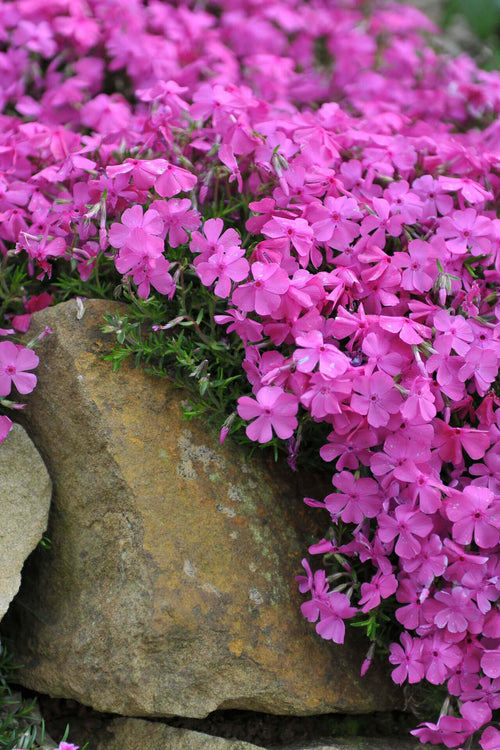Maximizing Space and Beauty
Gardening has evolved beyond traditional horizontal landscapes, venturing into verticality, where plants ascend walls and trellises to create stunning living tapestries. Vertical gardening, a practice that has gained immense popularity in recent years, allows gardeners to transform limited spaces into vibrant and flourishing oases. This innovative approach adds aesthetic value to homes and urban environments and presents a solution for those with constrained areas to cultivate greenery. Two remarkable plants that excel in vertical gardening are the creeping phlox (Phlox subulata) and the European ginger (Asarum europaeum), offering unique beauty and adaptability.
Creeping Phlox: A Cascading Carpet of Color
Creeping phlox (Phlox subulata), also known as moss phlox or ground phlox, is a low-growing perennial plant native to North America. Renowned for its ability to form dense, colorful mats that cascade over rocks, walls, and barriers, creeping phlox is a versatile gem in vertical gardening. One of the most captivating features of creeping phlox is its vibrant and diverse range of flower colors. From soft pastels like pink, lavender, and white to bolder shades of red, purple, and magenta, these flowers create a stunning visual display that captures attention and instills a sense of tranquility. The dense growth habit of creeping phlox adds depth and dimension to vertical spaces and serves as a natural weed suppressant. Creeping phlox thrives in well-draining soil and prefers full sun to light shade. Its adaptability to various soil types and conditions makes it an excellent candidate for vertical gardening. This plant's low maintenance requirements and resistance to pests and diseases make it a favorite among novice and experienced gardeners. As creeping phlox spreads, it forms a beautiful ground cover that provides visual continuity, connecting different garden elements.
European Ginger: A Lush Carpet in Shade
European ginger (Asarum europaeum) is another exceptional choice for vertical gardening, especially in areas with limited sunlight. Native to Europe, this perennial herbaceous plant thrives in shaded environments and is celebrated for its lush, glossy, heart-shaped leaves that create a dense carpet-like effect. One of the critical advantages of European ginger is its ability to flourish in low-light conditions. Many vertical spaces, such as walls shaded by buildings or trees, receive limited direct sunlight. European ginger's adaptability to shade makes it an ideal candidate for these spaces, bringing life and vibrancy to areas that might otherwise be overlooked. Its unique foliage adds texture and contrast, enriching the visual appeal of vertical gardens. European ginger is relatively low-maintenance, requiring consistently moist soil to thrive. Its ground-hugging growth habit covers vertical surfaces effectively, suppresses weed growth, and helps retain soil moisture, reducing the need for frequent watering. The plant's hardiness and resistance to pests make it an attractive choice for those looking to introduce greenery to shaded walls and spaces.
Benefits of Vertical Gardening
Vertical gardening offers a plethora of benefits that extend beyond mere aesthetics. Here are some of the advantages that make this gardening approach a compelling choice:
Space Optimization: One of the most prominent benefits of vertical gardening is its ability to maximize space. In urban environments or small yards, where horizontal space is limited, vertical gardens can utilize walls, fences, and other vertical surfaces for planting. This is particularly crucial for individuals who crave greenery but lack sufficient ground space.
Aesthetic Appeal: Vertical gardens are visually striking and can transform plain walls or structures into captivating living artworks. The combination of various plant textures, colors, and forms creates a dynamic and ever-changing display that enhances the overall ambiance of any space.
Improved Air Quality: Plants purify the air naturally, absorbing carbon dioxide and releasing oxygen. Vertical gardens contribute to improved air quality by increasing the number of plants within a confined space, thus enhancing oxygen production and reducing pollutants.
Temperature Regulation: Vertical gardens can act as insulators, providing a buffer against extreme temperatures. They can help keep indoor spaces more relaxed in hot weather and provide some degree of warmth in colder months.
Reduced Urban Heat Island Effect: The concentration of buildings and concrete surfaces in urban areas can lead to the "urban heat island" effect, causing higher temperatures. Vertical gardens combat this by providing shade and cooling products, mitigating the impact of heat.
Sound Absorption: Plants can absorb and muffle sound, making vertical gardens valuable in reducing noise pollution in busy urban environments.
Therapeutic Benefits: Gardening, in general, is known to have therapeutic effects on mental well-being. Vertical gardens, with their accessibility and manageable size, offer a convenient way for people to engage in gardening, even in limited spaces.
Biodiversity Support: Vertical gardens attract pollinators, birds, and insects, contributing to local biodiversity and creating micro-ecosystems within urban settings.
Vertical gardening is a captivating and practical approach to cultivating greenery, even in confined spaces. Plants like creeping phlox and European ginger exemplify the versatility and beauty that vertical gardening can bring. Whether adorning walls with cascading colors or turning shaded corners into lush retreats, these plants demonstrate the potential to create living works of art that enhance our surroundings. Beyond their aesthetic appeal, the numerous benefits of vertical gardening, from space optimization to improved air quality, underscore its significance in modern horticulture. As urbanization continues to shape our landscapes, vertical gardening is a testament to our ingenuity and connection to the natural world.



















































